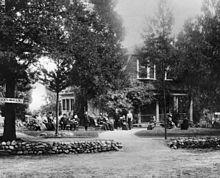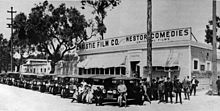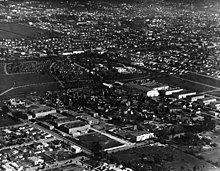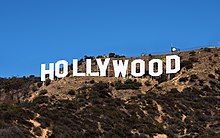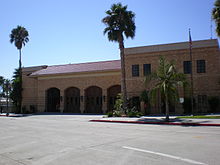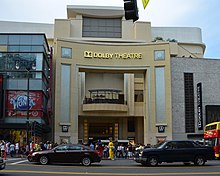Hollywood
Hollywood is a neighborhood in the city of Los Angeles, California, United States, which has become a metonym for the American film industry. Founded as a municipality in 1903, it merged with the city of Los Angeles in 1910, and shortly thereafter a major film industry emerged that would eventually become the best known in the world. Many studios, such as those of Columbia, Disney, Paramount, Warner or Universal, were founded here; Paramount still has its studios in this neighborhood.
History
Initial development
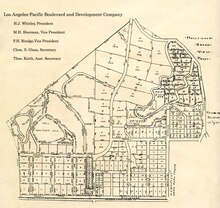
H. J. Whitley, a real estate developer, managed to buy E. C. Hurd's 1.9 km² ranch. They agreed on a price and closed the deal. Whitley shared his plans for the new city with General Harrison Gray Otis, editor of the Los Angeles Times , and with Ivar Weid, a prominent businessman in the area.
Daeida Wilcox, who donated land to help develop Hollywood, learned the name Hollywood from an acquaintance who owned a farm of that name in Illinois. Ms. Wilcox stated: "I chose the name Hollywood simply because it sounds good and because I'm superstitious and holly brings good luck." She recommended the same name to her husband, Harvey H. Wilcox, who had purchased 120 acres of land on February 1, 1887, although it was not until August 1887 that Wilcox decided to use that name and filed a deed and map with the Los Angeles County Land Register. property.
In 1900, the area had a post office, a newspaper, a hotel, and two markets. Los Angeles, with a population of 102,479, lay about 10 miles to the east and was separated from Hollywood by vineyards, barley fields, and citrus groves. A streetcar line ran through the center of Prospect Avenue (present-day Hollywood Boulevard), connecting Hollywood with Los Angeles, but services were infrequent and the journey took two hours. The former citrus packing plant was converted into a horse stable, improving transportation for Hollywood residents.
The Hollywood Hotel was opened in 1902 by Whitley, who was the president of the Los Pacific Boulevard and Development Company. Ultimately acquiring Hurd's ranch and subdividing it, Whitley built the hotel to attract land buyers. Flanking the west side of Highland Avenue, the building faced Prospect Avenue, which, though still a dusty, unpaved gravel road, was regularly graded. The hotel would become internationally known and would become the center of Hollywood civic and social life and home to stars for many years to come.
Whitley's company built and sold one of Hollywood's first residential areas, the Ocean View Tract. Whitley went to great lengths to promote the area. He spent thousands of dollars installing electric lighting and building a bank and a road to the port of Cahuenga. The illumination spanned several blocks of Prospect Avenue. Whitley's land was centered around Highland Avenue, his 1918 development, Whitley Heights, was named for him.
Foundation and merger
Hollywood was founded as a municipality on November 14, 1903, by a vote of 88 in favor and 77 against. On January 30, 1904, Hollywood voters decided, by 113 votes in favor and 96 against, to prohibit the sale of alcohol in the city, except for medicinal uses. Hotels and restaurants were not allowed to serve wine or alcoholic beverages before or after meals.
In 1910, the city voted to merge with Los Angeles in order to provide an adequate water supply and access to its sewage system. Following annexation, Prospect Avenue's name was changed to Hollywood Boulevard and all civic numbers in the new neighborhood changed. For example, 100 Prospect Avenue, at the intersection with Vermont Avenue, became 6400 Hollywood Boulevard; and 100 Cahuenga Boulevard, at the intersection with Hollywood Boulevard, became 1700 Cahuenga Boulevard.
Film Industry
In 1908, at least thirty motion picture companies began setting up productions around Jacksonville, Florida, attracted by its mild winter climate, easy rail access, and cheaper labor than New York, but few a few years later they left due to extreme weather events on the East Coast and for political reasons. Kalem Studios was the first to arrive, in 1908, and in 1911 it was also the first to start producing in the Los Angeles area.
By 1912, several major motion picture companies had established their productions in the Los Angeles area. By the turn of the xx century, most film-related patents were owned by Thomas Edison's New Jersey-based Motion Picture Patents Company, and filmmakers were often sued and forced to stop their productions. To avoid this, filmmakers began to relocate to Los Angeles, where it was easier to evade attempts to enforce Edison's patents. In addition, the climate was ideal and provided quick access to several different sets. In this way, Los Angeles became the capital of the American film industry. The mountains, plains, and low land prices made Hollywood a good place to establish film studios.
Director D. W. Griffith was the first to make a film in Hollywood. His seventeen-minute short film In Old California was recorded in 1910 for the Biograph Company. Although Hollywood banned movie theaters—when it had none—before annexation, Los Angeles did not have this restriction. Hollywood's first studio, the Nestor Film Company, was founded by the New Jersey Centaur Film Company in October 1911 in a former service area located at 6121 Sunset Boulevard (at the corner of Gower Street). Soon four major film companies—Paramount, Warner Bros., RKO, and Columbia—would have studios in Hollywood, as well as several small companies and rental studios.
In the 1920s, Hollywood was the fifth largest industry in the country. In the 1930s, Hollywood studios became fully vertically integrated, as production, distribution, and exhibition were fully controlled by these companies, allowing Hollywood to produce some six hundred films a year. Hollywood was then nicknamed Tinseltown (literally, "Tinsel City") and the "Dream Factory" because of the glowing image of the movie industry.
Later development
In 1923, a large sign reading "HOLLYWOODLAND" was installed in the Hollywood Hills to advertise the new residential complex being built by developers Woodruff and Shoults. In 1949, the Hollywood Chamber of Commerce signed an agreement with the Los Angeles City Council to repair and rebuild the sign. The agreement stated that the "LAND" would be removed, so that the sign would read "HOLLYWOOD" and refer to the neighborhood instead of the residential complex.
In the early 1950s, the Hollywood Freeway was built, running through the northeast corner of the neighborhood. The Capitol Records Building, located on Vine Street, just north of Hollywood Boulevard, was built in 1956, and the Hollywood Walk of Fame was created in 1958 as a tribute to artists and other significant personalities in the entertainment industry. Its official inauguration was held on February 8, 1960.
In 1985, the Hollywood Boulevard shopping and entertainment district was listed on the National Register of Historic Places. In June 1999, the Hollywood extension of the Los Angeles Metro Red Line opened, connecting the Los Angeles Downtown Los Angeles with the San Fernando Valley and has three stations on Hollywood Boulevard, at its intersections with Western Avenue (Hollywood/Western), Vine Street (Hollywood/Vine) and Highland Avenue (Hollywood/Highland). The Dolby Theatre, which opened in 2001 under the name of the Kodak Theater in the Hollywood and Highland shopping center, is the venue for the Oscars. This mall is located where the historic Hollywood Hotel was.
Revitalization
After the neighborhood went through years of decline in the 1980s, many landmarks were threatened with demolition. Columbia Square, on the northwest corner of the intersection of Sunset Boulevard and Gower Street, is part of the present-day Hollywood renaissance. Completed in 1938, this Art Deco studio complex, formerly the Hollywood headquarters of CBS, became home to a new generation of broadcasters when in 2014 the cable television networks MTV, Comedy Central, BET, and Spike TV set up their offices there as part of a $420 million office, residential, and commercial project. Since 2000, Hollywood has gentrified at an increasingly rapid pace due to its revitalization, promoted by private companies and public institutions. Between 2001 and 2016, more than 1,200 hotel rooms have been built in the Hollywood area. In 2019, four thousand new apartments and more than thirty building projects were approved.
In 1994, Hollywood, Alabama and ten other locations bearing the Hollywood name successfully fought an attempt by the Hollywood Chamber of Commerce to register the name and force other locations bearing the same name to pay it. royalties.
Secession Movement
In 2002, some Hollywood voters campaigned for the neighborhood to be separated from Los Angeles and become a separate municipality. In June of that year, the Los Angeles County Board of Supervisors called secession referendums for Hollywood and the San Fernando Valley on the ballot. To pass, the approval of a majority of voters in the proposed new township as well as a majority of voters in all of Los Angeles was required. In the November elections of that year, both proposals failed by a large majority of the city's vote.
Geography
According to the Los Angeles Times Mapping L.A. project, the Hollywood neighborhood is bordered by the Hollywood Hills to the north, Los Feliz to the northeast, East Hollywood or Virgil Village to the east, and Larchmont to the east. and Hancock Park to the south, with Fairfax to the southwest, West Hollywood to the west, and the Hollywood Hills West to the northwest.
The streets that make up the boundaries of Hollywood are: to the north, Hollywood Boulevard from La Brea Avenue to the eastern boundary of Wattles Garden Park and Franklin Avenue between Bonita Avenue and Western Avenue; to the east, Western Avenue; to the south, Melrose Avenue; and to the west, La Brea Avenue, which borders the West Hollywood Township.
In 1918, H. J. Whitley commissioned architect A. S. Barnes to design a Mediterranean-style town in the hills off Hollywood Boulevard, to be called Whitley Heights and become the first celebrity community. Other areas of Hollywood include Franklin Village, Little Armenia, Spaulding Square, Thai Town, and Yucca Corridor.
Climate
Like the rest of Los Angeles, Hollywood has a typical Mediterranean (Köppen: Csa) or dry subtropical climate. Winters are usually mild and rainy, although there are also many warm and sunny days. Summers are hot, sunny, and dry, with virtually no rainfall between April and October; although summer days can be warm, they are considerably cooler than in the San Fernando Valley. Spring and fall are generally warm, sunny, and pleasant. The Santa Ana winds blow frequently in the fall and winter, although they can blow any month of the year; these winds carry higher temperatures and lower humidity levels, increasing the risk of wildfires, especially in dry years. During the summer smog can appear. May and June can be foggy and overcast, a phenomenon dubbed by Southern Californians May Gray or June Gloom. The maximum temperature recorded in Hollywood is 44 °C on June 26, 1990, and the minimum is –4 °C on December 8, 1978 and December 23, 1990.
| Month | Ene. | Feb. | Mar. | Open up. | May. | Jun. | Jul. | Ago. | Sep. | Oct. | Nov. | Dec. | Annual |
|---|---|---|---|---|---|---|---|---|---|---|---|---|---|
| Temp. max. abs. (°C) | 32.8 | 32.8 | 34.4 | 41.1 | 38.9 | 44.4 | 41.7 | 40.6 | 43.3 | 42.2 | 37.8 | 33.3 | 44.4 |
| Average temperature (°C) | 20 | 21.1 | 21.1 | 23.3 | 23.9 | 26.7 | 29.4 | 30 | 28.9 | 26.7 | 22.8 | 20.6 | 24.4 |
| Temp. medium (°C) | 8.3 | 9.4 | 10.6 | 11.7 | 13.9 | 16.1 | 17.8 | 18.3 | 17.8 | 15 | 10.6 | 8.3 | 13.3 |
| Temp. min. abs. (°C) | -2.2 | 1.1 | 1.7 | 2.8 | 5.6 | 9.4 | 11.7 | 10.6 | 7.8 | 4.4 | 1.1 | -4.4 | -4.4 |
| Total precipitation (mm) | 88.1 | 96.8 | 82.3 | 21.6 | 7.9 | 1.8 | 0.5 | 3.6 | 8.9 | 9.9 | 29.5 | 50.3 | 401.3 |
| Source No. 1: MyForecast and MSN (extreme values) | |||||||||||||
| Source No. 2: PlantMaps (medias) | |||||||||||||
Demographics
The 2000 United States Census counted 77,818 residents in the 9.09 km² neighborhood of Hollywood, with an average of 8,569 inhabitants per km², making it the seventh most densely populated neighborhood in Los County Angels. In 2008 the City Council estimated that its population had increased to 85,489. The median age of its residents was thirty-one, around the city average.
Hollywood was considered "very diverse" ethnically compared to the city as a whole. In 2000, their ethnic composition was as follows: 42.2% Latino or Hispanic, 41% non-Hispanic white, 7.1% Asian, 5.2% black, and 4.5% other. Mexico (21.3%) and Guatemala (13%) were the places of more frequent births than 53.8% of residents who were born abroad, a figure considered high for the city.
The median household income was $33,694 in 2008 dollars, considered low for Los Angeles. Median household size, 2.1 people, was also below the city average. 92.4% of the homes were occupied by renters, and the rest by owners.
The percentages of never-married men (55.1%), never-married women (39.8%) and widows (9.6%) were among the highest in the county. There were 2,640 single-parent families, about the average for Los Angeles. In the year 2000, there were 2,828 veterans, making up 4.5% of the population, a low number for the city as a whole. The percentage of residents Hollywood residents at least twenty-five years of age who had a four-year college degree made up 28% of the population, about the same as the county as a whole.
Radio and television
KNX was the last radio station to broadcast from Hollywood, until in 2005 it left CBS Columbia Square —located on Sunset Boulevard— for a studio on the Miracle Mile. On January 22, 1947, it began broadcast in Hollywood the first commercial television station west of the Mississippi River, KTLA. In December of that same year, The Public Prosecutor became the first television series filmed in Hollywood. Television stations KTLA and KCET, both on Sunset Boulevard, were the last stations (radio or television) to be based in Hollywood, but KCET sold its studios to the Church of Scientology and moved to another location. KNBC moved in 1962 from the former NBC Radio City Studios at the intersection of Sunset Boulevard and Vine Street to NBC Studios in Burbank. KTTV moved in 1996 from its former headquarters at Metromedia Square on Sunset Boulevard to West Los Angeles, and KCOP left its La Brea Avenue headquarters to join KTTV. KCBS-TV and KCAL-TV moved from CBS Columbia Square to new facilities at the CBS Studio Center in Studio City.
Government
As a neighborhood within the Los Angeles borough, Hollywood does not have its own municipal government, but the Hollywood Chamber of Commerce appointed an "honorary mayor of Hollywood" for ceremonial purposes: Johnny Grant held this position from 1980 to his death on January 9, 2008.
Emergency Services
The Los Angeles Police Department is responsible for police services in the neighborhood. The Hollywood Police Station is located at 1358 North Wilcox Avenue. The Los Angeles Fire Department has four fire stations in the area: 27, 41, 52, and 82. The Department of Police Services The County of Los Angeles Health manages the Hollywood-Wilshire Health Center.
Post Office
The United States Postal Service operates the Hollywood Post Office, the Hollywood Pavilion Post Office, and the Sunset Post Office.
Neighborhood Tips
Hollywood is included in the Hollywood United Neighborhood Council (HUNC), the Hollywood Hills West Neighborhood Council, and the Hollywood Studio District Neighborhood Council. ">neighborhood councils) have advisory roles in matters such as urban planning, planning and other community issues. Members of these councils are elected by stakeholders, defined as anyone who lives, works, owns property, or belongs to an organization within of council boundaries.
Special events
The Oscars have been held (since 2004) at the end of February or beginning of March of each year, in recognition of the achievements of the film industry obtained in the previous year. Before 2004, they were held at the end of March or beginning of April. Since 2002, the Oscars have been presented at the Dolby Theater (formerly the Kodak Theatre), located at the intersection of Hollywood Boulevard and Highland Avenue.
The annual Hollywood Christmas Parade runs along Hollywood Boulevard and is broadcast in the Los Angeles area by KTLA, and nationally by Tribune-owned stations and WGN America.
Since 2012, the Hollywood Half Marathon has been held in April each year to raise money for local youth homeless shelters and awareness for the cause. The event includes a half marathon, 10K and 5K races, and a kids' fun run along Hollywood Boulevard.
Contenido relacionado
Icelandic art
Philippine Academy of the Spanish Language
Emilia Guiu
